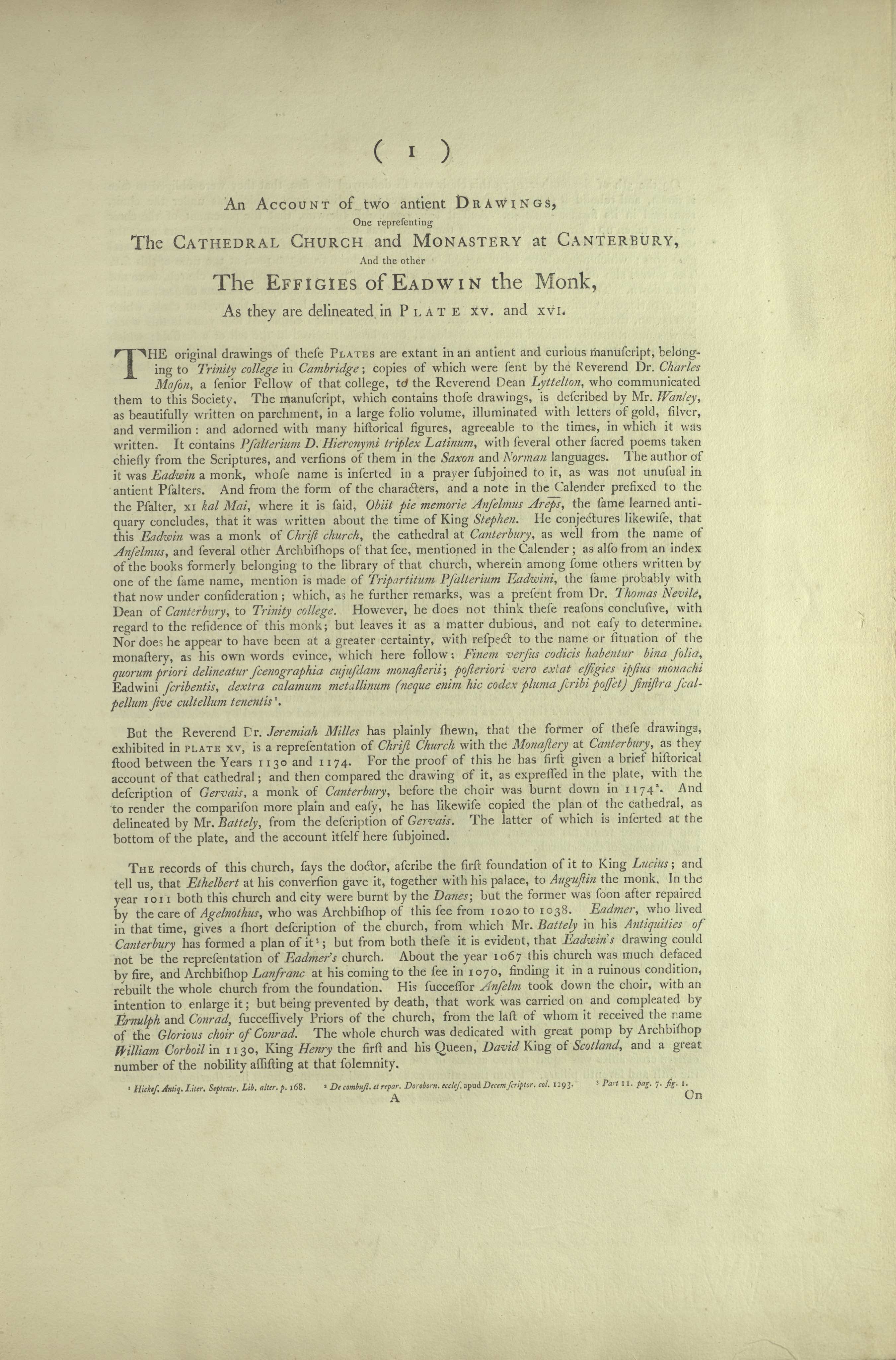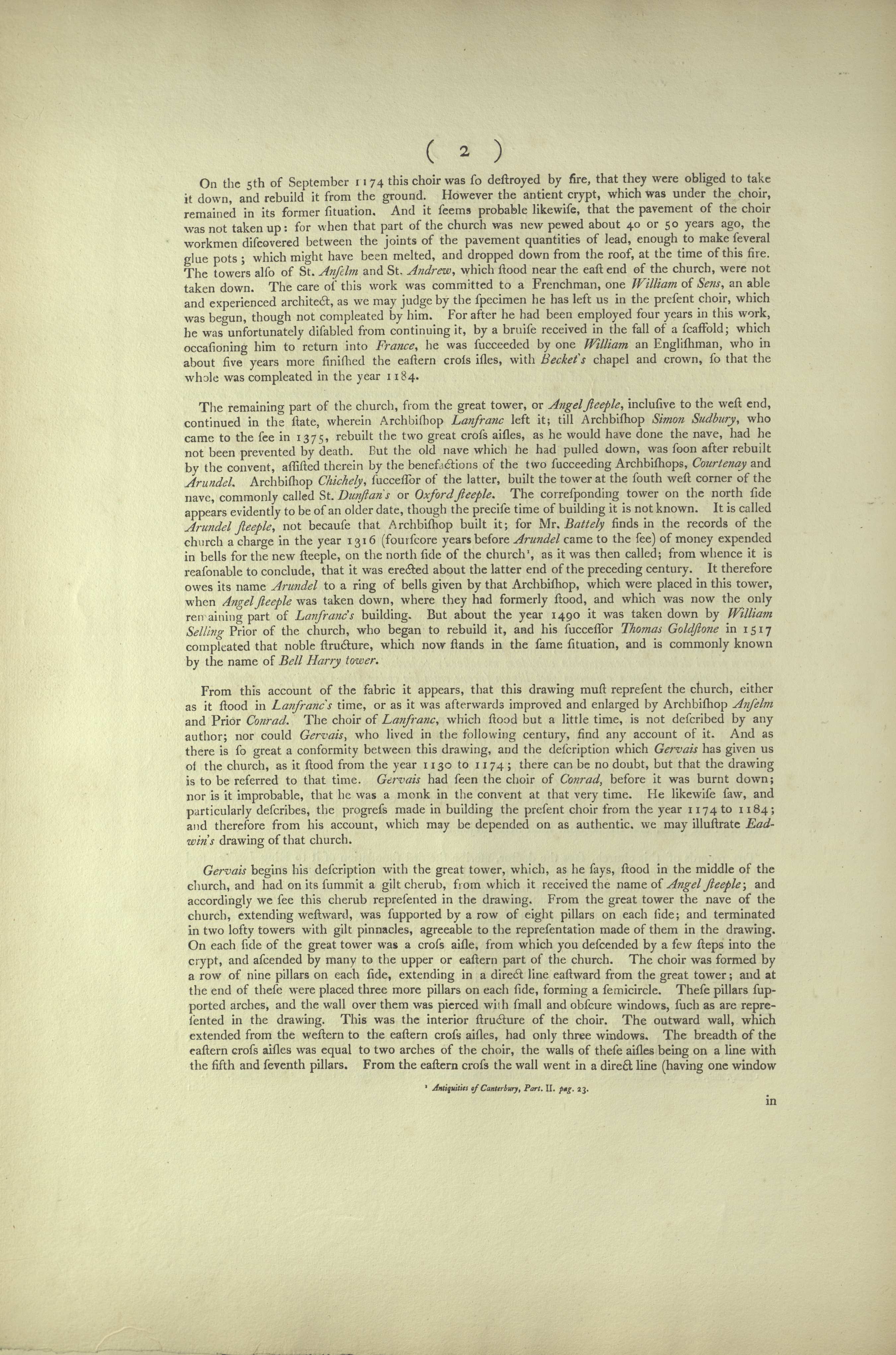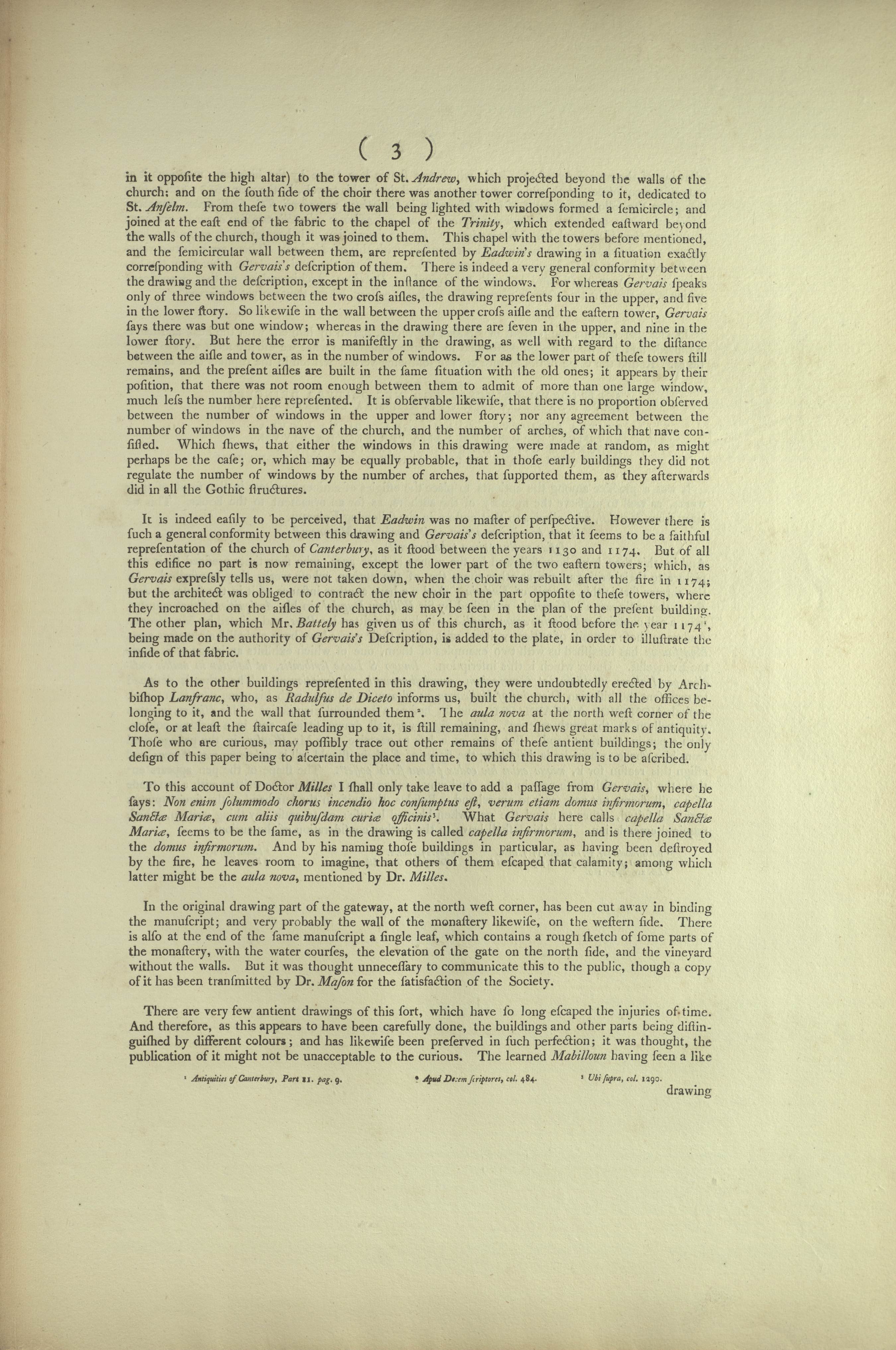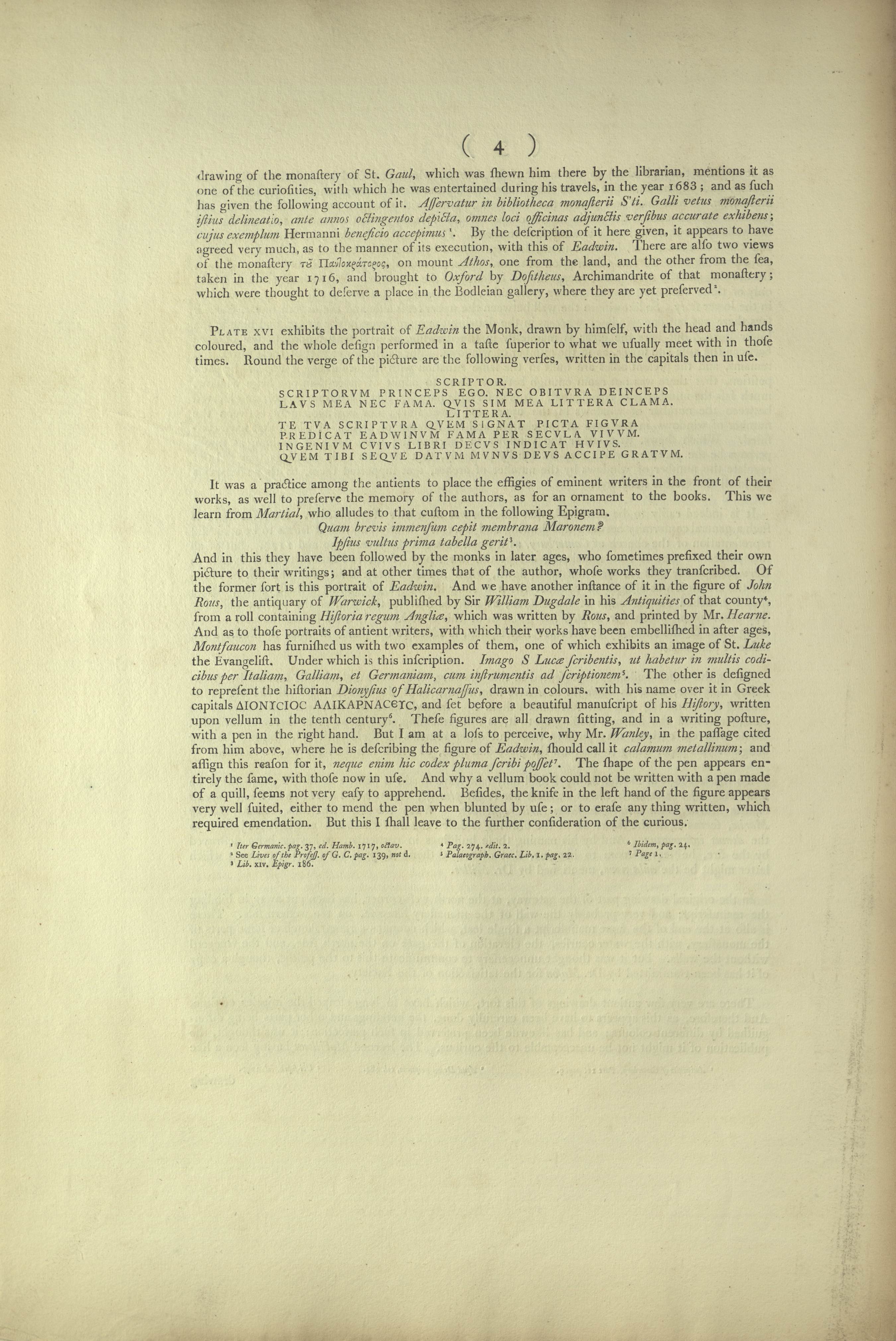
Creative Commons Attribution-Noncommercial-No Derivative Works 3.0
Plates 2.15-2.16: Canterbury Cathedral and Priory with a Portrait of Eadwine (Original Explanatory Account)
1 media/vm1-02-cropped.jpg 2020-06-06T02:58:41+00:00 Quanah Leija-Elias fc578bb41a53b12f2a08253bc8cc52547b2ff8bb 31 67 Original Explanatory Account for Vetusta Monumenta, Plates 2.15-2.16. plain 2021-12-25T00:39:34+00:00 Mary-Claire Sarafianos b64b0f9cad2b567cca4c9f2022b28f5bd47876a6
([Page] 1)
An ACCOUNT of two antient DRAWINGS, One representing The CATHEDRAL CHURCH and MONASTERY at CANTERBURY, And the other The EFFIGIES of EADWIN the Monk, As they are delineated in PLATE XV. and XVI.
Read more/less...
THE original drawings of these PLATES are extant in an antient and curious manuscript, belonging to Trinity college in Cambridge; copies of which were sent by the Reverend Dr. Charles Mason, a senior Fellow of that college, to the Reverend Dean Lyttleton, who communicated them to this Society. The manuscript, which contains those drawings, is described by Mr. Wanley, as beautifully written on parchment, in a large folio volume, illuminated with letters of gold, silver, and vermilion: and adorned with many historical figures, agreeable to the times, in which it was written. It contains Psalterium D. Hieronymi triplex Latinum [St. Jerome’s triple-column Latin psalter], with several other sacred poems taken chiefly from the Scriptures, and versions of them in the Saxon and Norman languages. The author of it was Eadwin a monk, whose name is inserted in a prayer subjoined to it, as was not unusual in antient Psalters. And from the form of the characters, and a note in the Calend[a]r prefixed to the Psalter, XI kal Mai [April 21], where it is said, Obiit pie memorie Anselmus Ar[chi]ep[iscopu]s [died Archbishop Anselm of blessed memory], the same learned antiquary concludes, that it was written about the time of King Stephen. He conjectures likewise, that this Eadwin was a monk of Christ church, the cathedral at Canterbury, as well from the name of Anselmus, and several other Archbishops of that see, mentioned in the Calendar; as also from an index of the books formerly belonging to the library of that church, wherein among some others written by one of the same name, mention is made of Tripartitum Psalterium Eadwini [Eadwine’s three-part psalter], the same probably with that now under consideration; which, as he further remarks, was a present from Dr. Thomas Nevile, Dean of Canterbury, to Trinity college. However, he does not think these reasons conclusive, with regard to the residence of this monk; but leaves it as a matter dubious, and not easy to determine. Nor does he appear to have been at a greater certainty, with respect to the name or situation of the monastery, as his own words evince, which here follow: Finem versus codicis habentur bina folia, quorum priori delineatur scenographia cujusdam monasterii; posteriori vero extat effigies ipsius monachi Eadwini scribentis, dextra calamum metallinum (neque enim hic codex pluma scribi posset) sinistra scalpellum sive cultellum tenentis [see end of document for translation]1.
But the Reverend Dr. Jeremiah Milles has plainly shewn, that the former of these drawings, exhibited in PLATE XV, is a representation of Christ Church with the Monastery at Canterbury, as they stood between the Years 1130 and 1174. For the proof of this he has first given a brief historical account of that cathedral; and then compared the drawing of it, as expressed in the plate, with the description of Gervais, a monk of Canterbury, before the choir was burnt down in 11742. And to render the comparison more plain and easy, he has likewise copied the plan of the cathedral, as delineated by Mr. Battely, from the description of Gervais. The latter of which is inserted at the bottom of the plate, and the account itself here subjoined.
THE records of this church, says the doctor, ascribe the first foundation of it to King Lucius; and tell us, that Ethelbert at his conversion gave it, together with his palace, to Augustin the monk. In the year 1011 both this church and city were burnt by the Danes; but the former was soon after repaired by the care of Agelnothus, who was Archbishop of this see from 1020 to 1038. Eadmer, who lived in that time, gives a short description of the church, from which Mr. Battely in his Antiquities of Canterbury has formed a plan of it3; but from both these it is evident, that Eadwin’s drawing could not be the representation of Eadmer’s church. About the year 1067 this church was much defaced by fire, and Archbishop Lanfranc at his coming to the see in 1070, finding it in a ruinous condition, rebuilt the whole church from the foundation. His successor Anselm took down the choir, with an intention to enlarge it; but being prevented by death, that work was carried on and compleated by Ernulph and Conrad, successively Priors of the church, from the last of whom it received the name of the Glorious choir of Conrad. The whole church was dedicated with great pomp by Archbishop William Corboil in 1130, King Henry the first and his Queen, David King of Scotland, and a great number of the nobility assisting at that solemnity.
1 Hickes. Antiq. Liter. Septentr. [Linguarum veterum septentrionalium thesaurus grammatico-criticus et archaeologicus] Lib. alter. [vol. II] p. 168.
2 De combust. et repar. Doroborn. Eccles. [Gervase’s account of the burning and rebuilding of Catnerbut Cathedral] apud Decem scriptor [in Historiae Anglicanae Scriptores Decem]. col[umn]. 1293.
3 Part II. pag. 7. fig. 1.

([Page] 2)
On the 5th of September 1174 this choir was so destroyed by fire, that they were obliged to take it down, and rebuild it from the ground. However the antient crypt, which was under the choir, remained in its former situation.
Read more/less...
And it seems probable likewise, that the payment of the choir was not taken up: for when that part of the church was new pewed about 40 or 50 years ago, the workmen discovered between the joints of the pavement quantities of lead, enough to make several glue pots; which might have been melted, and dropped down from the roof, at the time of this fire. The towers also of St. Anselm and St. Andrew, which stood near the east end of the church, were not taken down. The care of this work was committed to a Frenchman, one William of Sens, an able and experienced architect, as we may judge by the specimen he has left us in the present choir, which was begun, though not completed by him. For after he had been employed four years in this work, he was unfortunately disabled from continuing it, by a bruise received in the fall of a scaffold; which occasioning him to return into France, he was succeeded by one William an Englishman, who in about five years more finished the eastern cross isles, with Becket’>s chapel and crown, so that the whole was compleated in the year 1184.
The remaining part of the church, from the great tower, or Angel steeple, inclusive to the west end, continued in the state, wherein Archbishop Lanfranc left it; till Archbishop Simon Sudbury, who came to the see in 1375, rebuilt the two great cross aisles, as he would have done the nave, had he not been prevented by death. But the old nave which he had pulled down, was soon after rebuilt by the convent, assisted therein by the benefactions of the two succeeding Archbishops, Courtenay and Arundel. Archbishop Chichely, successor of the latter, built the tower at the south west corner of the nave, commonly called St. Dunstan’s or Oxford steeple. The corresponding tower on the north side appears evidently to be of an older date, though the precise time of building it is not known. It is called Arundel steeple, not because that Archbishop built it; for Mr. Battely finds in the records of the church a charge in the year 1316 (fourscore years before Arundel came to the see) of money expended in bells for the new steeple, on the north side of the church1, as it was then called; from whence it is reasonable to conclude, that it was erected about the latter end of the preceding century. It therefore owes its name Arundel to a ring of bells given by that Archbishop, which were placed in this tower, when Angel steeple was taken down, where they had formerly stood, and which was now the only remaining part of Lanfranc’s building. But about the year 1490 it was taken down by William Selling Prior of the church, who began to rebuild it, and his successor Thomas Goldstone in 1517 compleated that noble structure, which now stands in the same situation, and is commonly known by the name of Bell Harry tower.
From this account of the fabric it appears, that this drawing must represent the church, either as it stood in Lanfranc’s time, or as it was afterwards improved and enlarged by Archbishop Anselm and Prior Conrad. The choir of Lanfranc, which stood but a little time, is not described by any author; nor could Gervais, who lived in the following century, find any account of it. And as there is so great a conformity between this drawing, and the description which Gervais has given us of the church, as it stood from the year 1130 to 1174; there can be no doubt, but that the drawing is to be referred to that time. Gervais had seen the choir of Conrad, before it was burnt down; nor is it improbable, that he was a monk in the convent at that very time. He likewise saw, and particularly describes, the progress made in building the present choir from the year 1174 to 1184; and therefore from his account, which may be depended on as authentic, we may illustrate Eadwin’s drawing of that church.
Gervais begins his description with the great tower, which, as he says, stood in the middle of the church, and had on its summit a gilt cherub, from which it received the name of Angel steeple; and accordingly we see this cherub represented in the drawing. From the great tower the nave of the church, extending westward, was supported by a row of eight pillars on each side; and terminated in two lofty towers with gilt pinnacles, agreeable to the representation made of them in the drawing. On each side of the great tower was a cross aisle, from which you descended by a few steps into the crypt, and ascended by many to the upper or eastern part of the church. The choir was formed by a row of nine pillars on each side, extending in a direct line eastward from the great tower; and at the end of these were placed three more pillars on each side, forming a semicircle. These pillars supported arches, and the wall over them was pierced with small and obscure windows, such as are represented in the drawing. This was the interior structure of the choir. The outward wall, which extended from the western to the eastern cross aisles, had only three windows. The breadth of the eastern cross aisles was equal to two arches of the choir, the walls of these aisles being on a line with the fifth and seventh pillars. From the eastern cross the wall went in a direct line (having one window
1 Antiquities of Canterbury, Part. II. pag. 23.

([Page] 3)
in it opposite the high altar) to the tower of St. Andrew, which projected beyond the walls of the church: and on the south side of the choir there was another tower corresponding to it, dedicated to St. Anselm. From these two towers the wall being lighted with windows formed a semicircle; and joined at the east end of the fabric to the chapel of the Trinity, which extended eastward beyond the walls of the church, though it was joined to them.
Read more/less...This chapel with the towers before mentioned, and the semicircular wall between them, are represented by Eadwin’s drawing in a situation exactly corresponding with Gervais’s description of them. There is indeed a very general conformity between the drawing and the description, except in the instance of the windows. For whereas Gervais speaks only of three windows between the two cross aisles, the drawing represents four in the upper, and five in the lower story. So likewise in the wall between the upper cross aisle and the eastern tower, Gervais says there was but one window; whereas in the drawing there are seven in the upper, and nine in the lower story. But here the error is manifestly in the drawing, as well with regard to the distance between the aisle and tower, as in the number of windows. For as the lower part of these tower still remains, and the present aisles are built in the same situation with the old ones; it appears by their position, that there was not room enough between them to admit of more than one large window, much less the number here represented. It is observable likewise, that there is no proportion observed between the number of windows in the upper and lower story; nor any agreement between the number of windows in the nave of the church, and the number of arches, of which that nave confifled. Which shews, that either the windows in the drawings were made at random, as might perhaps be the case; or, which may be equally probable, that in those early buildings they did not regulate the number of windows by the number of arches, that supported them, as they afterwards did in all the Gothic structures.
It is indeed easily to be perceived, that Eadwin was no master of perspective. However there is such a general conformity between this drawing and Gervais’s description, that it seems to be a faithful representation of the church of Canterbury, as it stood between the years 1130 and 1174. But of all this edifice no part is now remaining, except the lower part of the two eastern towers; which, as Gervais expressly tells us, were not taking down, when the choir was rebuilt after the fire in 1174; but the architect was obliged to contract the new choir in the part opposite of these towers, where they incroached on the aisles of the church, as may be seen in the plan of the present building. The other plan, which Mr. Battely has given us of this church, as it stood before the year 11741, being made on the authority of Gervais’s Description, is added to the plate, in order to illustrate the inside of the fabric.
As to the other buildings represented in this drawing, they were undoubtedly erected by Archbishop Lanfranc, who, as Radulfus de Diceto informs us, built the church, with all of the offices belonging to it, and the wall that surrounded them2. The aula nova [new hall] at the north west corner of the close, or at least the staircase leading up to it, is still remaining, and shews great marks of antiquity. Those who are curious, may possibly trace out other remains of these antient buildings; the only design of this paper being too ascertain the place in time, to which this drawing is to be ascribed.
To this account of Doctor Milles I shall only take leave to add a passage from Gervais, where he says: Non enim solummodo chorus incendio hoc consumptus est, verum etiam domus infirmorum, capella Sanctae Mariae, cum aliis quibusdam curiae officinis [see end of document for translation]3. What Gervais here calls capella Sanctae Mariae, seems to be the same, as in the drawing is called capella infirmorum [infirmary chapel], and is there joined to the domus infirmorum. And by his naming those buildings in particular, as having been destroyed by the fire, he leaves room to imagine, that others of them escaped that calamity; among which latter might be the aula nova, mentioned by Dr. Milles.
In the original drawing part of the gateway, at the north west corner, has been cut away in binding the manuscript; and very probably the wall of the monastery likewise, on the western side. There is also at the end of the same manuscript a single leaf, which contains a rough sketch of some parts of the monastery, with water courses, the elevation of the gate on the north side, and the vineyard without the walls. But it was thought unnecessary to communicate this to the public, though a copy of it has been transmitted by Dr. Mason for the satisfaction of Society.
There are very few antient drawings of this sort, which have so long escaped the injuries of time. And therefore, as this appears to have been carefully done, the buildings and other parts being distinguished by different colours; and has likewise been preserved in such perfection; it was thought, the publication of it might not be unacceptable to the curious. The learned Mabilloun having seen a like
1 Antiquities of Canterbury, Part II. pag. 9.
2 Apud Decem scripearri [Historiae Anglicanae Scriptores Decem], col. 484.
3 Ubi suquo [ibid.], col. 1292.

([Page] 4)
drawing of the monastery of St. Gaul, which was shewn him there by the librarian, mentions it as one of the curiosities, with which he was entertained during his travels, in the year 1683; and as such has given the following account of it.
Read more/less...Asservatur in bibliotheca monasterii S’ti. Galli vetus monasterii istius delineatio, ante annos octingentos depicta, omnes loci officinas adjunctis versibus accurate exhibens; cujus exemplum Hermanni beneficio accepimus [translation here]1. By the description of it here given, it appears to have agreed very much, as to the manner of its execution, with this of Eadwin. There are also two views of the monastery τοῦ Παντοκράτορος [Christ Pantocrator], on mount Athos, one from the land, and the other from the sea, taken in the year 1716, and brought to Oxford by Dositheus, Archimandrite of that monastery; which were thought to deserve a place in the Bodleian gallery, where they are yet preserved2.
PLATE XVI exhibits the portrait of Eadwin the Monk, drawn by himself, with the head and hands coloured, and the whole design performed in a taste superior to what we usually meet with in those times. Round the verge of the picture are the following verses, written the capitals then in use.
SCRIPTOR.
SCRIPTORVM PRINCEPS EGO. NEC OBITVRA DEINCEPS LAVS MEA NEC FAMA. QVIS SIM MEA LITTERA CLAMA.
LITTERA.
TE TVA SCRIPTVRA QVEM SIGNAT PICTA FIGVRA PREDICAT EADWINVM FAMA PER SECVLA VIVVM. INGENIVM CVIVS LIBRI DECVS INDICAT HVIVS. QVEM TIBI SEQVE DATVM MVNVS DEVS ACCIPE GRATVM. [see end of document for translation]
It was a practice among the antients to place the effigies of eminent writers in the front of their works, as well to preserve the memory of the authors, as for an ornament to the books. This we learn from Martial, who leads to that custom in the following Epigram.
Quam brevis immensum cepit membrana Maronem?
Ipsius vultus prima tabella gerit3.
[How small a quantity of parchment has comprised vast Maro!
The first leaf bears his own countenance. (Loeb Classics translation)]
And in this they have been followed by the monks in later ages, who sometimes prefixed their own picture to their writings; and at other times that of the author, whose works they transcribed. Of the former sort is this portrait of Eadwin. And we have another instance of it in the figure of John Rous, the antiquary of Warwick, published by Sir William Dugdale in his Antiquities of that country4, from a roll containing Historia regum Angliae [History of the English Kings], which was written by Rous, and printed by Mr. Hearne. And as to those portraits of antient writers, with which their works have been embellished in after ages, Montfaucon has furnished us with two examples of them, one of which exhibits and image of St. Luke the Evangelist. Under which is this inscription. Imago S Lucae scribentis, ut habetur in multis codicibus per Italiam, Galliam, et Germaniam, cum instrumentis ad scriptionem5. [Image of St. Luke writing, as he is found (lit. “held”) in many codices throughout Italy, Gaul, and Germany, with instruments for writing.] The other is designed to represent the historian Dionysius of Halicarnassus, drawn in colours, with his name over it in Greek capitals ΔIONYCIOC AΛIKAPNACEYC, and set before a beautiful manuscript of his History, written upon vellum in the tenth century6. These figures are all drawn fitting, and in a writing posture, with a pen in the right hand. But I am at a loss to perceive, why Mr. Wanley, in the passage cited from him above, where he is describing the figure of Eadwin, should call it calamum metallinum [metal pen]; and assign this reason for it, neque enim hic codex pluma scribi posset [for it was not possible to write this book with a quill pen]7. The shape of the pen appears entirely the same, with those now in use. And why a vellum book could not be written with a pen made of a quill, seems not very easy to apprehend. Besides, the knife in the left hand of the figure appears very well suited, either to mend the pen when blunted by use; or to erase any thing written, which required emendation. But this I shall leave to the further consideration of the curious.
1 [Mabillon,] Iter. Germanic.[um pag. 37, ed. Hamb. 1717, octav.
2 See Lives of the Profess. of G.[resham] C.[ollege] pag. 139, not[e] d.
3 Lib. [Book] XIV. Epigr.[am] 186.
4 Pag. 274. edit. 2.
5 Palaeograph. Graec. [Palaeographia Graeca] Lib. [Book] I. pag. 22.
6 Ibidem, pag. 24.
7 Page 1.
Translations of the Longer Latin Passages:
Page 1, lines 21-24: Toward the end of the codex there are found two leaves, on the former of which is a scenographia [a map drawn with perspective] of a monastery; on the latter is a portrait of the monk himself, Eadwine, writing, holding a metal pen in his right hand (for this codex could not be inscribed with a feather quill), a scalpel or knife in his left hand.
Page 3, lines 40-42: For not only was the choir destroyed by this fire, but also the Infirmary Hall, the Chapel of St. Mary, along with some other offices (or “workshops/storerooms”) of the Court.
Page 4, lines 3-5: Preserved in the monastery of St. Gall is an old sketch of that monastery, drawn eight hundred years ago, accurately showing all the offices (or “workshops/storerooms”) of the place, with accompanying verses. We came by a copy of it owing to Hermann’s kindness.
Page 4, lines 13-20: The scribe: I am the chief of scribes, and neither my praise nor my fame shall die; shout out, oh my letter, who I may be. The letter: By its fame your script proclaims you, Eadwine, whom the painted figure represents, alive through the ages, whose genius the beauty of this book demonstrates. Receive, O god, the book and its donor as an acceptable gift. (Heslop 1992, 180)